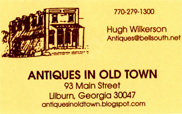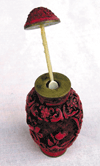|
Cinnabar
Lacquerware
By Carrie Springer
|
 |
Cinnabar is the popular name used to describe Chinese lacquerware of a
striking red color known for many centuries. When first produced, the
distinctive color was derived from a mineral known as cinnabar that is
scientifically described as mercuric sulfide, being meta-cinnabar or massive
cinnabar. This mineral is the red mercury you see in older thermometers, and it
is highly toxic. Its effects produce a wide range of mental and psychological
conditions. When combined with lacquer, mercuric sulfide can leach through to
exposed skin in measurable, but arrested, amounts to pose a health risk. The
toxicity of mercury and cinnabar appears to have been recognized before 2000
B.C. when the task of mining quicksilver was assigned to slaves and
prisoners.
|
|

Contact
us to
place
your
antique
shop or antique
related
information
here.
|
|
It is the distinctive color of this moderately rare mineral that
has lent its identity of a deep coral red, known as Cinnabar Red, that is
closely identified with classic Asian works of art, from pottery to fabric. This
mineral is only found in significant quantities near hot springs or volcanic
sites in Spain, Serbia, the Hunan Province of China and the United States in
California, Oregon, Texas and Arkansas.
Lacquerware is any type of object
that is coated with or formed from a distillate of the sap from the lac tree,
common to the area now claimed by China's central and southern regions. The lac
tree, which is of the sumac family like poison ivy and poison oak, is tapped
much like a maple tree to gain its sap. The resulting gum is purified by heating
and then made into lacquer by adding a solvent.
There is also a cinnabar tree
(common name) that is a very soft and widely used because it is easily carved or
molded. It plays no role however, in the production of cinnabar lacquerware.
This soft wood is often incorporated into household and decorative items and
layered with many coats of lacquer. With deep red pigments added to either the
wood or the over-coats of lacquer, this type of wooden piece is also sometimes
referred to as cinnabar for its coloring, but it is chiefly a product of Japan,
now being reproduced throughout Asia.
Cinnabar lacquerware is known to have
existed some 2,300 years, but that date may be extended back to the very early
days of China. In 1955, Neolithic remains at Tuanjie Village and Meiyan Township
(both in Wujiang County, Jiangsu Province) were unearthed, and a number of
lacquer-painted black pottery objects were discovered intact. They are the
earliest lacquered articles ever discovered in China and are now kept in the
Museum of Nanjing.
Cinnabar lacquerware is almost always comprised solely of
lacquer or lacquer built on a metal, wooden or bamboo armature. Later techniques
have sometimes incorporated molding the basic shape from a lacquer-based clay
before layering. To create lacquerware, from 200 to 500 coats are applied,
depending upon the size of the piece. This requires months or even years of
effort to establish the base for the traditional ornate carvings that are
distinctive of cinnabar lacquerware. Each layer of the lacquer is applied and
then dried until the desired thickness is achieved before carving or
ornamentation can begin. In some cases, layers of varying colors have been
incorporated to great stylistic effect.
Lacquer does not dry like paint. It
cures as the liquid medium in which it is dissolved undergoes a process of
evaporation, leaving the lacquer to harden as it chemically interacts with
humidity in the air. Traditional carvers used dust-free cabinets to store items
for curing between the numerous applications to keep it pure.
The vast
majority of pieces available on the market today in the United States are
mid-18th to mid-19th century. There are some rarer pieces that have found their
way into the marketplace that date from the 17th century, but earlier examples
that date back to the 15th century are mostly held in private collections of
Asian artifacts. Because of the hardy nature of lacquer, there is a good number
of surviving pieces of great antiquity. Many examples dating to before the 13th
century are held in museums, but because of their photosensitivity, are rarely
exhibited.
Because of the complexity of producing items out of cinnabar
lacquer, they were rarely designed as utilitarian objects. The use of small
trays and platters was common in the ritualized Japanese Tea Ceremony, and
flower vases were often used on altars to honor ancestors. These in cinnabar
lacquerware were often highly prized heirlooms that were passed on from one
generation to the next. Various themes can be found on cinnabar lacquerware that
signify traditional meanings. Sacred birds, flowers, dragons and scenes
illustrate the spiritual connection between the piece itself and its
function.
The value of a piece is determined by the age, the condition and
the workmanship. The age must be determined by appraisal or identification of
the artist's mark, usually found on the bottom of the piece. To determine the
condition, examine the piece under magnification for cracks and fissures. The
primary considerations for quality are the preservation of the color and lack of
chipping.
Workmanship, however, seems to be the determining factor as to
price at auction. The carving must be performed while the lacquer is still soft
enough to be cut evenly with a sharp knife. Consequently, the artisan must be a
master carver, for the incisions made by the point of the knife should not show,
and the corners should be completely rounded out. When carving landscapes,
palaces, figures, birds and animals, artisans strive to achieve the effect of a
painting. The piece is then finished by drying and polishing.
Today, other
pigments such as vermilion and even polymers and synthetics have been used to
mass-produce items for export. While these are much safer and may mimic the
intricate artistry exhibited in work produced before the latter half of the 20th
century, they are easily identified because they lack the character and
uniqueness of the older creations.
Cinnabar lacquer pieces should not be
allowed to stay wet for any extended period of time. They should be dusted, not
washed, and if wet accidentally, they should be dried as quickly as possible. It
is advisable to use latex gloves when handling wet cinnabar lacquer, even though
most pieces have been sealed with clear lacquer to prevent the transfer of
mercury through the skin or onto dust that can be inhaled.
Mercuric sulfide
is also photosensitive. To preserve the value and rich coloration of cinnabar
lacquer, it should not be displayed under strong artificial light or in direct
(or even filtered) sunlight. The pigment will darken considerably and can lose
its patina, which with age begins to adopt a look and feel akin to human
skin.
Cinnabar lacquerware is certainly beautiful treasures
|

This carved cinnabar lacquer snuff bottle with figural landscape scene sold
for $800 + bp last February at IM Chait Auction in Beverly Hills.
(Photo,
IM Chait)

Cinnabar vase, late 18th C., displaying fine artistry of flora
and
fauna, also highlighting three sages and a servant on a veranda in a mountain
setting. Ht. 9.5", valued at $1,052.
(Photo, ineasterndreams.com)

(Right) Early-to mid-20th c. urn
with blue enamel lining on wooden
armature, about 14 1/2" in height.

Early 19th c. solid
lacquer decorative plate,
10 1/3", signed by
artist.

Qing dynasty (17th-18h century) cinnabar box and cover carved with a scene of
children playing outdoors beneath a pine tree. Offered for $4,600; 7 3/4" in
diameter. (Photo, Gilles Lorin, Asiantiques.com.)


Mid-to late-18th c. snuff
bottle with carved ivory spoon, about 2"
high.

Late 20th c.
egg-shaped
decorative piece.
Unless otherwise noted, pictured Cinnabar pieces are
from the private collection of
Carrie Springer, photographed
by Norman
Hail.
|